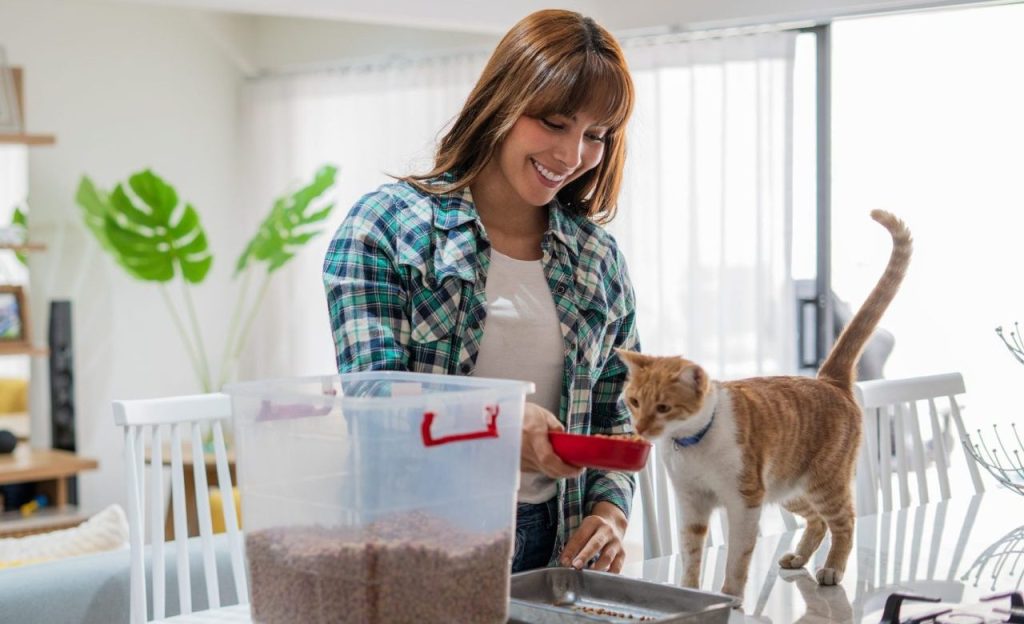Pet sitters can be lifesavers when you have to leave home and can’t take your cat with you. But it can also be nerve-wracking to leave your fur baby in the hands of someone else, even if they are an experienced professional. To ensure a smooth experience for both your cat and the pet sitter, proper preparation is crucial. In this comprehensive guide, we’ll show you how to prepare your cat and home for a pet sitter, ensuring your feline friend receives the best care possible in your absence.
Getting your home ready for a pet sitter
Clean and organize
Start by thoroughly cleaning your home, removing any clutter or hazards that could pose a risk to your cat or the pet sitter. Put away valuable items and fragile objects to prevent accidents.
Stock up on essential supplies
Stock up on your cat’s food, treats, medications, and any other supplies they may need during your absence. Ensure that you have enough to last throughout the entire pet-sitting period. Also, provide toiletries for the pet sitter as well as cleaning supplies for both human and feline messes.
Ensure access
Provide the pet sitter with any necessary codes or passwords for access to doors, gates, garages, the security system, and the internet. Also, leave a spare key for your pet sitter, even if you have a keypad lock. Keypad batteries can unexpectedly die, leaving no way to access the outside door. As a backup, consider providing a key to a trustworthy neighbor.
Pet-proofing
Remove any potentially harmful objects from your cat’s reach, such as plants, trash, or cleaning supplies. In stressful situations (i.e. your absence!), cats may exhibit unusual behaviors. To ensure their safety, consider confining your cat to a specific room.
Information to give your pet sitter
Detailed routine
Provide a detailed schedule of your cat’s daily routine, including feeding times, play habits, and any other specific instructions regarding their care, like how often you scoop the litter box. Inform the pet sitter about your cat’s preferences, such as favorite toys or games.
Contact information
Share your contact information, including your phone number, email address, and an alternate contact person in case of an emergency. Provide the contact details of your veterinarian and any necessary medical information about your cat.
Emergency protocols
Prepare a list of emergency procedures and contact numbers. Include your veterinarian’s contact information, as well as the nearest emergency veterinary clinic. Inform the pet sitter about your cat’s medical history, allergies, and any medications they are taking.
House rules
If the pet sitter will be staying in your home, provide clear guidelines on:
- Guest policy
- Sleeping arrangements
- Which bathrooms they may use
- If (and what) foods they may eat from your refrigerator, freezer, and pantry
- Operating household appliances, heating, and air conditioning
- When and how to lock doors, windows, fences/gates, and garage doors
Update parameters
Discuss with your pet sitter how often and through which medium (video calls, photos, texts, phone calls) you prefer to receive updates about your fur baby’s well-being.
Preparing your cat for the arrival of a pet sitter
Meet-and-greet
Before your pet sitter comes for the stay, allow your cat to become familiar with their presence. Cats can be wary of strangers, so it’s important to introduce them gradually. Set up a meeting between your cat and the pet sitter in a quiet, comfortable space. Encourage positive interactions by offering treats or engaging in playtime. This helps build trust and a positive association with the pet sitter.
Familiar belongings
Leave your cat’s favorite toys, blankets, or bedding accessible for the pet sitter. Having familiar items around can provide comfort and a sense of security for your cat. If your cat has a preferred sleeping spot or hiding place, let the pet sitter know.
Personality traits
Share any details on behavioral information with the pet sitter. Let them know about your cat’s temperament, including how they react to strangers, other animals, or specific triggers. Inform them of any known behavioral issues, such as scratching furniture or excessive meowing, and provide suggestions on how to redirect or manage these behaviors.
Identification
Ensure your cat wears a collar with an updated identification tag containing your contact information. Consider microchipping your cat if you haven’t already, and ensure that the registration details are up to date.
Leaving your cat in safe hands
By following these steps and thoroughly preparing your cat and home for a pet sitter, you can ensure a smooth and worry-free experience for both your furry friend and the caretaker. Effective communication, a well-prepared home environment, and comprehensive information will help your pet sitter provide the best care possible, allowing you to enjoy your time away with peace of mind.
Wondering if pet sitting is the best option for your cat while you’re away? Read up on the differences between boarding and pet sitters. Have an awesome pet sitter? Express your gratitude with one of these ways to say thank you.









